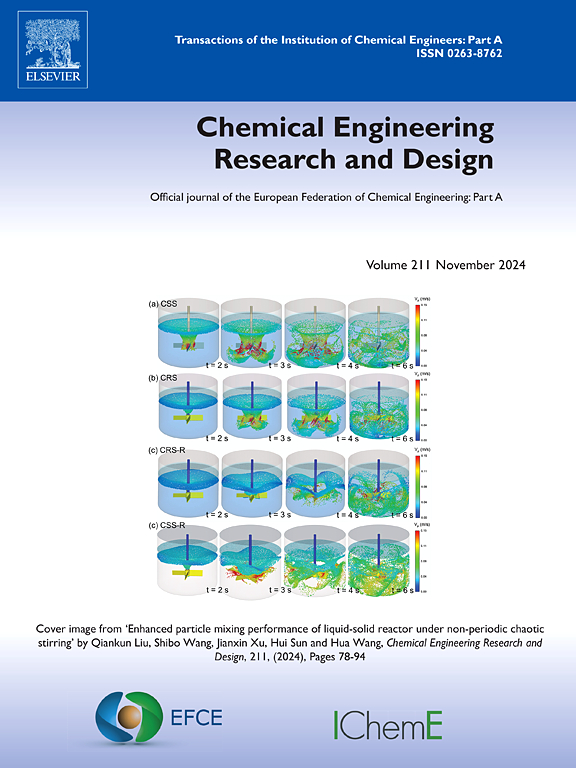水-油乳液稳定剂的比较分析:生物聚合物、表面活性剂和纳米颗粒
IF 3.7
3区 工程技术
Q2 ENGINEERING, CHEMICAL
引用次数: 0
摘要
乳剂在各种石油工程应用中发挥着至关重要的作用,特别是在提高石油采收率(EOR)方面。传统上,表面活性剂和聚合物被用来实现乳液的稳定性。本研究探索了天然、环保的生物聚合物作为稳定剂的潜力,并将其与传统表面活性剂和纳米颗粒的性能进行了比较。利用合成聚合物FLOPAAM、表面活性剂十六烷基三甲基溴化铵(CTAB)和十二烷基硫酸钠(SDS)以及疏水二氧化硅纳米颗粒,对琼脂(从红藻中提取)和果胶(从柑橘皮中提取)的生物聚合物的性能进行了评价。对最稳定的乳剂进行了综合分析,包括界面张力(IFT)测量、润湿性评估、动态光散射(DLS)和显微成像。结果表明,琼脂和果胶显著提高了乳状液的稳定性。例如,琼脂稳定乳液(0.3 wt%)在70 °C下加热一周后,水分离率仅为30 %。然而,琼脂浓度过高会引起不稳定性。相比之下,果胶需要更高的浓度(1 wt%)才能产生完全稳定的乳剂。蒸馏水制备的乳剂比海水制备的乳剂稳定性更好,高速机械搅拌进一步提高了乳剂的稳定性。琼脂使IFT从32.96 mN/m降低到22.25 mN/m,降低了接触角,促进了水-湿状态。此外,显微镜和DLS分析显示,琼脂显著降低了分散液滴的大小,液滴直径从1590 nm减小到450 nm。这些发现突出了琼脂和果胶作为石油应用中提高乳液稳定性的可持续替代品的潜力。本文章由计算机程序翻译,如有差异,请以英文原文为准。
Comparative analysis of water-oil emulsion stabilizers: Biopolymers, surfactants, and nanoparticles
Emulsions play a vital role in various petroleum engineering applications, particularly in enhanced oil recovery (EOR). Traditionally, surfactants and polymers have been used to achieve emulsion stability. This study explores the potential of natural, eco-friendly biopolymers as stabilizers and compares their performance with conventional surfactants and nanoparticles. The performances of agar (extracted from red algae) and pectin (derived from citrus peels) biopolymers were evaluated alongside the synthetic polymer FLOPAAM, surfactants Cetyltrimethylammonium bromide (CTAB) and sodium dodecyl sulfate (SDS), and hydrophobic silica nanoparticles. Comprehensive analyses, including interfacial tension (IFT) measurements, wettability assessments, dynamic light scattering (DLS), and microscopic imaging, were conducted on the most stable emulsions. The results demonstrated that agar and pectin significantly enhanced emulsion stability. For example, an agar-stabilized emulsion (0.3 wt%) exhibited only 30 % water separation after one week at 70 °C. However, excessive agar concentrations induced instability. In contrast, pectin required a higher concentration (1 wt%) to produce fully stable emulsions. Emulsions prepared with distilled water exhibited greater stability than those made with seawater, and high-speed mechanical stirring further improved stability. Agar reduced the IFT from 32.96 mN/m to 22.25 mN/m, decreased the contact angle, and promoted a water-wet condition. Moreover, microscopic and DLS analyses revealed that agar significantly decreased the dispersed droplet size, with droplet diameters reducing from 1590 nm to 450 nm. These findings highlight the potential of agar and pectin as sustainable alternatives for enhancing emulsion stability in petroleum applications.
求助全文
通过发布文献求助,成功后即可免费获取论文全文。
去求助
来源期刊

Chemical Engineering Research & Design
工程技术-工程:化工
CiteScore
6.10
自引率
7.70%
发文量
623
审稿时长
42 days
期刊介绍:
ChERD aims to be the principal international journal for publication of high quality, original papers in chemical engineering.
Papers showing how research results can be used in chemical engineering design, and accounts of experimental or theoretical research work bringing new perspectives to established principles, highlighting unsolved problems or indicating directions for future research, are particularly welcome. Contributions that deal with new developments in plant or processes and that can be given quantitative expression are encouraged. The journal is especially interested in papers that extend the boundaries of traditional chemical engineering.
 求助内容:
求助内容: 应助结果提醒方式:
应助结果提醒方式:


